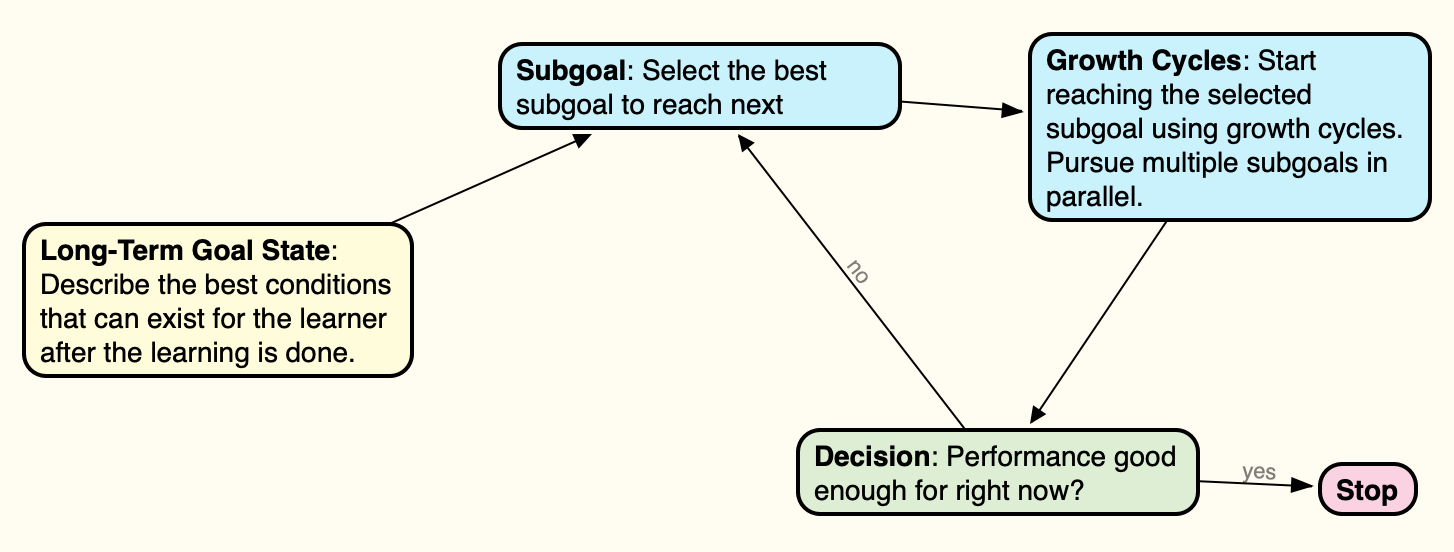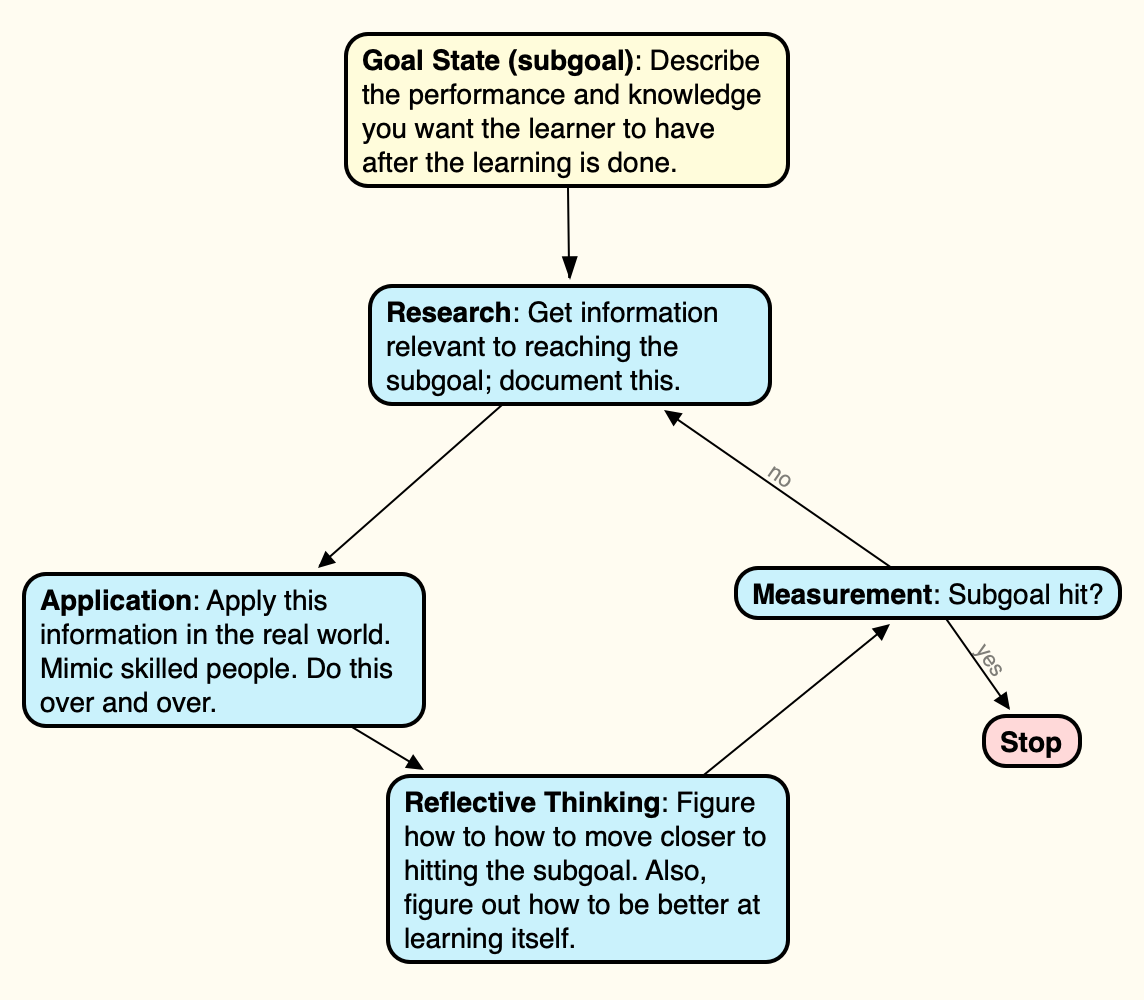How to Learn Effectively: The Method
- id: 1689172824
- Date: Dec. 1, 2024, 11:46 a.m.
- Author: Donald F. Elger
Overview of Effective Learning
Effective learning (EL)—a method that I have learned and that I apply to me own learning, and that I use for teaching of others—is defined by its actions and its rewards.
Actions of EL: EL involves a set of actions: {long term goal, subgoals, growth cycles, reflective thinking, and so forth}.
Rewards of EL: When EL is skillfully applied, it provides a set of rewards: {super enjoyable learning, competence, minimum effort, least hassle, and so forth}.
EL can be applied to either your own learning or to teaching someone else.
A person can apply EL for their own learning in any context: school, job, sport, home, or what ever.
A teacher can apply EL to guide one or more student.
Teacher: A teacher refers to any person who is the role of helping a learner. Examples: manager, coach, professor, K12 teacher, mentor, peer, and so on.
In either role, teaching or learning, the set of actions that make up EL are the same. The only difference is whether the action are organized and structured by the learner or by the teacher.
The EL Method (Main Actions)
Fig. 1 summarizes the main actions of EL.
 ![[effective-learning.scap]]
![[effective-learning.scap]]
Figure 1: A summary of the EL method
EL begins by setting a long term goal that emphasizes performance.
To reach this goal, we break the long-term goal into subgoals and reach one subgoal after another until performance is good enough to pause learning.
Subgoals are reached by using growth cycles.
Growth Cycles
The heart of the EL method is the growth cycle (Figure 2), which is a method for reaching a subgoal. A growth cycle is synonymous with deliberate practice.
 Figure
2: The main actions associated with a growth cycle.
Figure
2: The main actions associated with a growth cycle.
![[growth-cycles.scap]]
Subgoals for Learning A subgoal is selected such that the following criteria are met: useful today,
Examples
The EL method is super simple
Set a long term goal. Break this down into subgoals. Reach a given subgoal by engaging in growth cycles.
Learning French
Long Term Goal: Communicate fluently in French
Subgoals: 1. Correct articulation of French sounds. 2. Be proficient with common greetings and everyday expressions. 3. Comprehensive knowledge of numbers and basic vocabulary. 4. Master French verb tenses and conjugations. 5. Understand lyrics in French songs. 6. Read and comprehend French children’s books. 7. Effectively converse with native speakers. 8. Grasp idiomatic expressions and colloquialisms. 9. Comprehend French news articles, broadcasts, films, and so on. 10. Write simple essays or diary entries in French. 12. Be proficient with direct and indirect object pronouns. 13. Navigate everyday scenarios in French-speaking regions, from shopping to asking for directions to dining.
Then, reach each subgoal by using growth cycles. Each growth cycle involves these actions: get good information, apply this information in the real world, use reflective thinking to move closer to attaining the subgoal. Do this growth cycle over and over until you’ve reached the given subgoal.
Learning Chemistry
Long Term Goal: Apply the main ideas of chemistry to useful things: solve problems, make decisions, do calculations, explain how the world works, and so on.
Subgoals:
Describe the periodic table, including groups, periods, and characteristics of its elements.
Explain atomic structure, electron configurations, and the principles underlying them.
Predict chemical bonding types and molecular structures, and provide justifications for these predictions.
Describe stoichiometry principles and demonstrate the ability to balance chemical equations.
Explain the first and second laws of thermodynamics and apply them to example chemical reactions.
Analyze chemical kinetics, describe the factors that affect reaction rates, and predict outcomes based on given conditions.
Explain the principles behind acid-base and redox reactions and demonstrate sample calculations.
Describe the foundations of organic chemistry, including the characteristics of hydrocarbons and functional groups.
Explain the concept of chemical equilibrium and utilize Le Chatelier’s principle in hypothetical scenarios.
Describe and calculate properties related to solution chemistry, like molarity, molality, and percent composition.
Conduct a laboratory experiment following safety protocols, and draft a report outlining findings.
Analyze given experimental data, identifying patterns, outliers, and drawing conclusions.
Relate molecular structure to properties by explaining intermolecular forces in a given set of compounds.
Describe the effects of specific chemicals on ecosystems and their role in environmental chemistry.
Utilize specific technology or software to model molecular structures and predict their behavior.
Reach subgoals by using subgoals. Once you’ve hit the subgoals, you have reached the long term goal.
The Pattern
Set a long term goal that describes performance.
Break the long term goal down into subgoals.
Progressively reach subgoals by engaging in growth cycles.